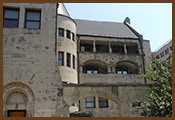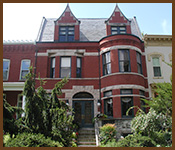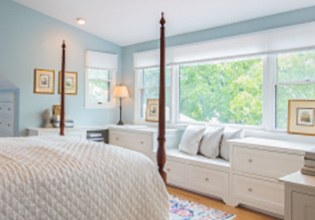Henry Hobson Richardson Buildings in DC
 Richardsonian Romanesque
Richardsonian RomanesqueStyle Building on 16th Street
in NW Washington, DC
Have you heard of Richardsonian Romanesque architecture? There are many buildings and homes with this style in the Washington, DC area. The architect this eclectic style is named after, Henry Hobson Richardson, was extremely influential in his time.
H.H. Richardson Architecture
Richardson designed a pair of homes for Henry Adams and John Hay. They were constructed simultaneously in 1884 on two adjoining lots at the corner of 16th and H Street NW. In 1927, the houses were demolished and the current Hay-Adams Hotel was built and named for the previous homeowners—Hays and Adams.
Adams, who had been a classmate of Richardson’s at Harvard and was a close friend of Adams, persuaded Hay to purchase the adjoining lots near the White House and to build their homes with Richardson as the architect.
The Hay & Adams Homes
The Adams house was described as comfortable and informal, while the Hay residence was formal and elegant. Mrs. Adams knew just what she wanted (“a Spartan little box”) while the Hays had no strong ideas of how the design should be handled. In fact, the Adams produced schematic floor plans for the architect to abide by. The Hay House, the more unusual of the two, was more the result of Richardson’s creativity.
Hay and Adams loved their homes and remained there until their deaths. These dwellings were among the finest in the city at the time. The Adams house was a gathering place for the intellectuals of the day. President Roosevelt visited often during his presidency. The Hay House was also a spectacular place for entertaining, as it was built and furnished to serve as just that.
 Richardsonian Romanesque
Richardsonian RomanesqueStyle Building on East Capitol
Street in SE Washington, DC
Surprisingly, several architectural components of the John Hay and Henry Adams residences were salvaged when they were torn down in 1927 and repurposed for two homes built in the DC neighborhood of Woodland-Normanstone. One is at 2618 31st street NW. These architectural elements consisted of stone work framing an entry that now frames a garage door and the home’s front door. Also salvaged was a custom paneled entry door, framed in cut stone, designed by Richardson, which was repurposed in a 1920s era home at 3014 Woodland Drive, NW.
The Influence of H.H. Richardson
Richardson’s architectural designs became so popular that it evolved into its own style, Richardsonian Romanesque, and was taken up by architects and builders throughout the United States between 1880 and 1900. Many fine residential examples can be found in the Capitol Hill historic district.







